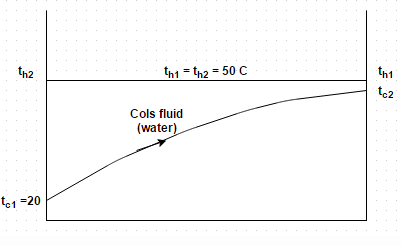Test: Heat Exchanger Effectiveness - Chemical Engineering MCQ
10 Questions MCQ Test - Test: Heat Exchanger Effectiveness
A single pass shell and tube heat exchanger, consisting of a bundle of 100 tubes (inner diameter 25 mm and thickness 2 mm) is used for heating 28 kg/s of water from 25 degree Celsius to 75 degree Celsius with the help of a steam condensing at atmospheric pressure on the shell side with condensing heat transfer coefficient 5000 W/m2 degree. Make calculation for overall heat transfer coefficient based on the inner area. Take fouling factor on the water side to be 0.002 m2 degree/W per tube and neglect effect of fouling factor on the shell side and thermal resistance of the tube wall

Which of the following is not associated with heat exchanger?
The engine oil at 150 degree Celsius is cooled to 80 degree Celsius in a parallel flow heat exchanger by water entering at 25 degree Celsius and leaving at 60 degree Celsius. Estimate the exchanger effectiveness
Consider the above problem, if the fluid flow rates and the inlet conditions remain unchanged, workout the lowest temperature to which the oil may be cooled by increasing length of the exchanger
In a surface condenser, the water flowing through a series of tubes at the rate of 200 kg/hr is heated from 15 degree Celsius to 75 degree Celsius. The steam condenses on the outside surface of tubes at atmospheric pressure and the overall heat transfer coefficient is estimated at 860 k J/m2 hr degree. Find the effectiveness of the heat exchanger. At the condensing pressure, stream has saturation temperature 0f 100 degree Celsius and the latent heat of vaporization is 2160 k J/kg. Further, the steam is initially just saturated and the condensate leaves the exchanger without sub-cooling i.e. only latent heat of condensing steam is transferred to water. Take specific heat of water as 4 k J/kg K
Consider the above problem, find the tube length. Let the diameter of tube is 25 mm
For evaporators and condensers, for the given conditions, the logarithmic mean temperature difference for parallel flow is
Water (specific heat = 4 k J/kg K) enters a cross flow exchanger (both fluids unmixed) at 15 degree Celsius and flows at the rate of 7.5 kg/s. It cools air (C P = 1 k J/kg K) flowing at the rate of 10 kg/s from an inlet temperature of 120 degree Celsius. For an overall heat transfer coefficient of 780 k J/m2 hr degree and the surface area is 240 m2, determine the NTU
Consider the above problem, find the capacity ratio of the heat exchanger



















